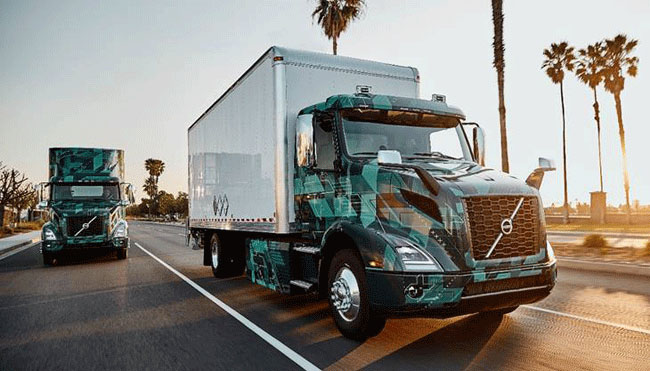Volvo Trucks North America showed its battery-electric Class 8 truck at an event in Fontana, California.
The Volvo Low Impact Green Heavy Transport Solutions (LIGHTS) Innovation Showcase, held at Volvo Trucks’ TEC Equipment dealership, revealed the progress that has been achieved since the announcement of the Volvo LIGHTS project in late 2018. Guests experienced the fully electric project trucks firsthand for the first time.
Volvo LIGHTS is a collaboration between 15 public and private partners to demonstrate the viability of all-electric freight hauling in high-density traffic and urban areas.
“We’re excited to share the milestones reached and lessons learned in the development of a battery-electric transport eco-system,” said Peter Voorhoeve, president, in a prepared statement. “This project is unique in the sense of its scope, and that it takes into account the entire system from charging stations to yard haulers to solar panels to workforce development to heavy-duty trucks. We are putting trucks on the road and fully testing them in real-world commercial applications, proving out this innovative approach to learn and prepare for commercial operations for zero-emission freight hauling.”
Officials from California Air Resources Board (CARB) and South Coast Air Quality Management District (South Coast AQMD) were also present, along with representatives from each of the project partners. The Volvo LIGHTS project was made possible by an award to South Coast AQMD of $44.8 million from CARB as part of California Climate Investments (CCI). CCI is a statewide initiative that puts billions of Cap-and-Trade dollars to work reducing greenhouse gas emissions, strengthening the economy and improving public health and the environment – particularly in disadvantaged communities.
“This forward-thinking coalition has developed both a zero-emission truck and the whole eco-system that supports these state-of-the-art vehicles, from charging to maintenance and repair. This is what it takes to transform this critical freight-hauling sector,” said California Air Resources Board chair Mary D. Nichols. “This project will put more ultra-clean, zero-emission trucks on the roads and highways of communities like Fontana and Ontario that are heavily burdened with growing diesel truck traffic. Volvo Trucks’ vision is helping to clean the air in the communities that need it most.”
Volvo Group contributed $36.7 million for the project total of $90 million, and South Coast AQMD contributed $4 million from the Clean Fuels Fund, administers the grant and oversees the Volvo LIGHTS project.
“Our partnership with Volvo Group began with efforts to develop a prototype of a hybrid-electric diesel truck, something that was novel in the industry at the time. Now, we have reached a huge milestone that lays a path for the commercialization of fully electric truck technologies,” said Wayne Nastri, executive officer for the South Coast AQMD. “These battery-electric trucks showcased today will have positive air quality impacts in local communities across our region, but especially in disadvantaged communities that need it most.”
At the Innovation Showcase, interactive knowledge-sharing sessions from Volvo Trucks North America and several Volvo LIGHTS project partners demonstrated the installation of charging stations, dealership service and support preparations, technician training programs and workforce development, the positive environmental impacts due to a zero-emission transport system and more.
Guests at the event were also able to ride and drive the first five pilot Volvo VNR Electric trucks on a closed course at the Fontana Speedway near the TEC Equipment facility. The tailored course was set up to demonstrate the Volvo VNR Electric project trucks’ features such as propulsion and regeneration energy, maneuverability, quietness and ease of operation.
The Volvo VNR Electric project trucks will be put into real-world commercial operations with two of California’s leading freight companies, Dependable Supply Chain Services and NFI. Volvo Trucks engineers and project managers will closely monitor and evaluate the vehicles’ performance, driving cycles, load capacity, uptime, range and other parameters in these real-world applications over the next several months. The company will take those learnings into the final stages of product development and begin the first phase of serial production and commercial offering of the Volvo VNR Electric in late 2020.
Guests at the Fontana event also learned about the technology transfer that helped Volvo Trucks North America develop and deliver all-electric, heavy-duty trucks in just one calendar year.
“Volvo Trucks is leading the way in electric transport globally,” said Keith Brandis, vice president of partnerships and strategic solutions, Volvo Group. “We relied a great deal on the technological know-how of our sister company Volvo Buses, which has already built over 5,000 hybrid and electric vehicles, and on Volvo Trucks’ production of all-electric, medium-duty vehicles in Europe.”
Volvo LIGHTS project partner TEC Equipment will serve as a fully certified maintenance hub for the Volvo VNR Electric project trucks in the South Coast Air Basin. The dealership group is an established sales and service network that has partnered with local Rio Hondo College and San Bernardino Valley College to create electric vehicle repair and service technician programs to ensure fully trained and skilled technicians to support these new technologies. The company will also lease 15 battery-electric Volvo VNR Electric trucks to interested customers for real-world trials as part of the overall project scope, and offers a critical uptime support team for assistance with parts and service on these new electric vehicles.
“The Volvo LIGHTS project demonstrates that for the entire endeavor to come together, it takes more than just the truck. It’s the delivery of the complete eco-system for zero-emission, heavy-duty transport, and taking responsibility for that ecosystem,” said Voorhoeve. “You can only achieve this by having a common goal, fully integrated collaboration amongst all stakeholders, and agreeing to be pioneers together.”
Source: www.constructionequipment.com


